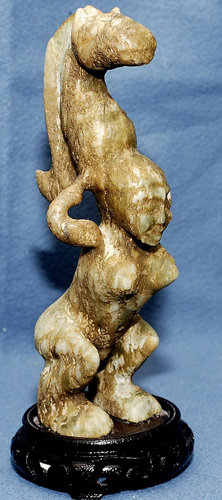|
T of C
Home |
My Work |
Hand- books |
Qin as Object |
Qin in Art |
Poetry / Song |
Hear, Watch |
Play Qin |
Analysis | History |
Ideo- logy |
Miscel- lanea |
More Info |
Personal | email me search me |
| Folio14 Qin biographies | 首頁 |
|
Nü Wa
- Qinshu Daquan, Folio 14, #2 2 |
女媧 1
琴書大全,第十四卷 #2 女媧琴式 Nü Wa's qin style 3 |
 Nü Wa (or Nü Gua), originally considered "the greatest primeval cosmogonic deity"4 and sometimes credited with controlling flooding,5 was later relegated to the position of a minor deity, consort of her older brother Fu Xi;6 in this latter role she was sometimes said to have had a human head but the body of a serpent.7
Nü Wa (or Nü Gua), originally considered "the greatest primeval cosmogonic deity"4 and sometimes credited with controlling flooding,5 was later relegated to the position of a minor deity, consort of her older brother Fu Xi;6 in this latter role she was sometimes said to have had a human head but the body of a serpent.7
The biography here says Nü Wa created the shenghuang mouth organ (or perhaps just its pipes).8 Her connection to the qin seems to come from the stories that say she accompanied Fuxi when he played the qin. However, although early lists of qin styles include a Fu Xi style, they do not include a Nü Wa style, having there only in a comment under the description of what is said to have been Fuxi's qin.
Nü Wa is not mentioned in Qin Shi or Qin Shi Bu. The biography here is brief, saying that we know she liked the qin because when Fu Xi played, she accompanied him.
The original text in Qinshu Daquan says,
Footnotes (Shorthand references are explained on a
separate page)
1.
女媧 Nü Wa references
(See Wiki and
Minghuang)
Her name is also written Nü Gua (or Nügua, Nü Kua) as well as Nüwa, Nu Wa and Nuwa.
6170.205-.208: 6170.206 女媧氏 has as its primary reference a quote from 司馬貞,補史記,三皇本紀 Sima Zhen's 7th c. CE supplement to Shi Ji, also quoted below. See also 10.975 三皇 San Huang, quoting Fengsu Tong, says she was one of the Three Majesties along with Fu Xi and Shen Nong. 6170.208 女媧陵 mentions several places claiming to be her gravesite.
Other references:
In The Classic of Mountains and Seas, Anne Birrell renders "女媧" as both "Girl Kua" and "Girl Lovely". See pp. xxiii, 173, 223, 224. On p.224 it says,
Her identity as half snake thus came later.
(Return)
2.
Original text (translation above)
Two lines (see QQJC V/295). The original text there is:
The source of the first half seems to be 補史紀,三皇記, although there the first phrase is, 「女媧氏亦風姓,蛇身人首,有神聖之德。無革造,惟作笙簧」 (i.e., it adds that her surname was Feng, she had the body of a snake and the head of a human, and [if I understand correctly] she made the shenghuang because she had no leather [to bind the pipes together?]). The second quote seems to be from Record of the Yellow Emperor, where it is actually written, 「伏羲置琴,女媧和之」.
(Elsewhere: 風姓: surnamed Feng? Feng gou)?
(Return)
3.
女媧琴式 Nü Wa's qin style
The original of this image, from a series
(宋人畫歷代琴式圖) that also includes one of her brother, Fu Xi, is in the 國立故宮博物院 National Palace Museum. For an image of Fuxi and Nüwa together see the next footnote; there they are both depicted as half-human and half-serpent. Further images of Nü Wa can easily be found on the internet, including in the Wikipedia article.
The full text at top is as follows:
Further references from this text:
Ao
(Wiki) 鰲 47439 (also: 47489; short entry: fish or turtle ["鼇" 49866]);
translations include: cosmic tortoise, giant turtle, sea turtle, etc. It is often depicted as a dragon with a shell shielding its back: Turtle Dragon?. Similar story here and other references in poems here and
here.
Mu De Wang 木德王 14750.330 木德 mentions 風姓 and 木德王.
Feng Xing 風姓 (surname Feng?) 44734.xxx
Translation uneven and incomplete, but only the first phrase mentions qin. A number of the characters are not clear in the original. Here they are interpreted by finding the various sources that the text has quoted.
(Return)
| 4. "The greatest primeval cosmogonic deity" | Nü Wa |
 Anne Birrell, Chinese Mythology, An Introduction, p.164.
Anne Birrell, Chinese Mythology, An Introduction, p.164.
Nü Wa as a fertility goddess is represented in the almost 9 inch high neolithic period image at right (expand). "She holds above her a 'head dragon'. As is characteristic, she has a slender poise (ready to raise a weight), with visible breasts and clitoris, two elements of a woman's body necessary to reproductive functions." (Image and comments courtesy of TWS.)
(Return)
5.
Nü Wa and the floods
Anne Birrell, op. cit., pp. 69-71 ("Nü Gua mends the sky"). mentions Nü Wa in connection with flood myths.
(Return)
6.
Nü Wa and Fu Xi
Anne Birrell, op. cit., p.163 - 165, discusses her in relation to Fu Xi.
(Return)
7.
Nü Wa as half serpent
Nü Wa and Fu Xi are shown together as entwined snakes in this image, which has Nü Wa on the left holding a compass and Fuxi on the right holding an ink ladle and carpenter's square. The original of that one is a painting on silk found at the Astana Graves (Wiki) in Xinjiang.
(Return)
8.
笙簧 Shenghuang
2631.15 says this is the reeds or pipes of the sheng mouth organ. The account above seems to suggest that she had no leather to bind the pipes together.
(Return)
Return to QSDQ ToC, or to the Guqin ToC.